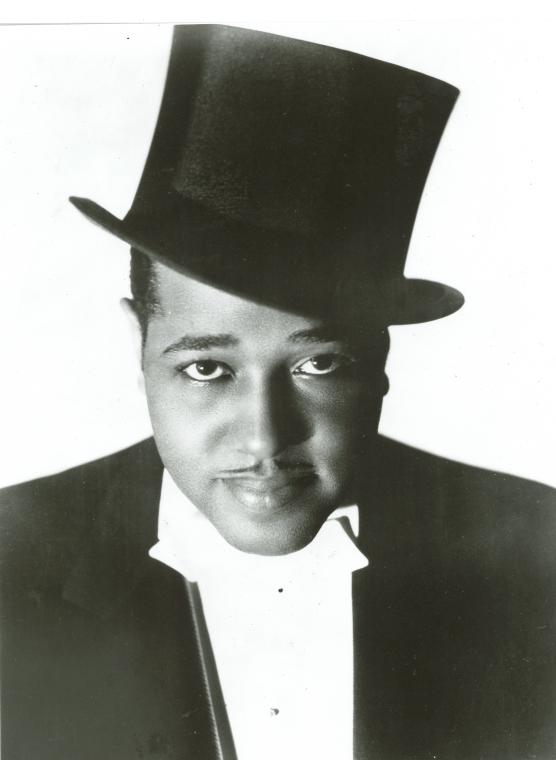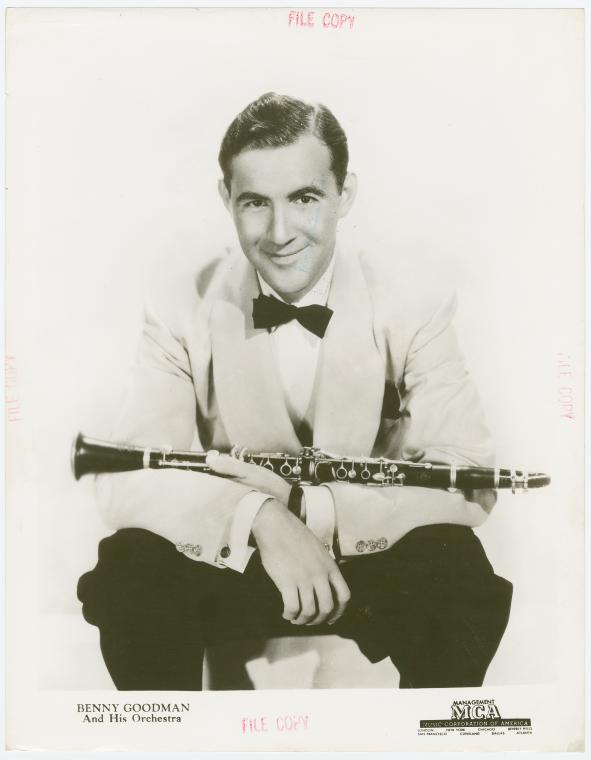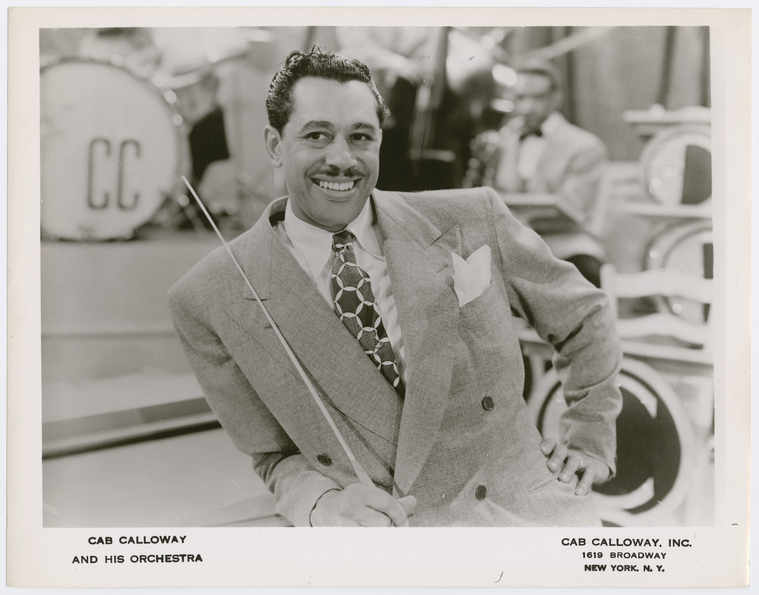Big Bands and the Swing Era
Back to Research > History > Musical Styles and Venues in America
The term “Big Band,” referring to Jazz, is vague but popular. The term generally refers to the swing era starting around 1935, but there was no one event that kicked off a new form of music in 1935. It had evolved naturally from the blues and jazz of New Orleans, Chicago and Kansas City.
Early Jazz developed in New Orleans where Buddy Bolden, King Oliver (a cornet player idolized by Louis Armstrong) and others performed at the turn of the century. Mississippi steamboats helped spread the new sound as many New Orleans jazz bands and musicians performed on the boats.
1917 saw the early recordings of the Original Dixieland Jass Band – white musicians playing the tunes and arrangements of black musicians. Despite the fact that they hadn’t invented anything, their recordings sold over a million copies and introduced jazz to all of America and the world.
In the 1920s the music of jazz began to evolve to bigger band formats combining elements of ragtime, black spirituals, blues, and European music. Duke Ellington, Ben Pollack, Don Redman, and Fletcher Henderson were some of the more popular early big bands. These groups nurtured young stars and future bandleaders like Coleman Hawkins, Benny Goodman, Glenn Miller, Red Allen, Roy Eldridge, Benny Carter, and John Kirby.
Duke Ellington
Benny Goodman
During the 1920s, while traveling musicians were playing and spreading big band jazz, hotel dance bands and resident dance hall bands were also playing a role in the evolution of the Big Band era. Paul Whiteman, The California Ramblers, Ted Lewis, Jean Goldkette, and Vincent Lopez were a few of the successful hotel dance bandleaders of the 1920s. They made their money playing for ballroom dance crowds and radio remote broadcasts into the early 1930s.
As the jazz orchestras grew in size, the arrangements had to be formalized to avoid mass confusion. The arranger became the focal point of the band. Improvisation during solos was written into the arrangements, but their location and duration were controlled. The big band sounds of The Dorsey Brothers, Fletcher Henderson, Cab Calloway, The Casa Loma Orchestra, and Duke Ellington’s orchestra as well as the vocal styling of The Mills Brothers, the Andrew Sisters and The Boswell Sisters were all carefully arranged, and the easy flowing style of the evolving jazz was becoming known as ‘Swing.’
Cab Calloway
As the new swing style emerged in the mid-1930s, it took the country by storm. The popularity of swing increased as people invented new dances to complement its driving rhythm. The Savoy Ballroom in Harlem opened its doors in 1926 and for the next 20 years became a hotbed for swing bands. It was at the Savoy that a dance style called the ‘Lindy Hop’ was invented and refined. Through the press, recordings, and live radio remote broadcasts the American public was introduced to the new music. The dance craze took off.
The Big Band Era – The Swing Era
The Big Band era is generally regarded as having occurred between 1935 and 1945. It was the only time in American musical history that the popularity of jazz eclipsed all other forms of music. To many, the appearance of Benny Goodman and his Big Band at the Palomar in Los Angeles in August of 1935 was the start of the Swing Era.
America was still in the grips of a depression. “Black Thursday” had occurred on October 24th, 1929 followed by the collapse of The New York Bank of the United States on December 11th, 1931. The prosperity and carefree times of the roaring 20s were over. Money was in short supply. The average person wasn’t able to afford to go out for live music or to buy records. There was very little work, especially for non-essential musicians. Record sales dropped to an all-time low. Some of the most talented or well-connected players got jobs at radio studios or with some of the few dance orchestras able to stay together.
In a strange convergence of politics and technology, radio became a household appliance in the 1930s. By 1935, the number of homes with radios was estimated at 23 million. That created an audience of approximately 91 million. It became known as the Golden Age Of Radio with shows like “The Shadow,” “Amos & Andy,” “Tarzan,” “Fibber McGee And Molly,” and “The Lone Ranger.” Studio musicians made their money as background instrumentalists for both shows and commercials. Music shows were also successful. Before 1934, dance and “sweet” bands still dominated the airwaves. Benny Goodman’s Let’s Dance broadcasts, which aired regularly in 1934, were one of the first such weekly live radio broadcasts of hot jazz to be aired by a national network on a regular basis. Given the economic conditions of the time it may be surprising that during this period advances in recording technology, and in particular, the microphone, were changing the way Americans could hear recorded music and radio broadcasts.
The advent of radio required advances in many related devices. The quality of broadcast sound depended upon the quality of the available microphones. The RCA model 44A ribbon or “velocity” microphone was introduced in 1931. It was remarkably efficient with natural compression and became one of the most widely used microphones in recording and broadcasting. In 1933 RCA raised the bar again and introduced the model 77A cardioid pattern dual ribbon microphone. Each advancement improved the sound quality and brought increasing subtlety and nuance to the broadcasts. As the microphones improved, the experience of radio became ever more intimate.
Simultaneously, there were advances in the recording discs as well. By the late 1930s, adding a bit of vinyl resin to shellac made quieter records. Lacquer-coated aluminum discs also came into use in the recording process. These had a quieter surface and for the first time allowed immediate playback in the studio for auditioning purposes. This made it possible for engineers and musicians to make immediate microphone and personnel placement adjustments further improving recordings. Live radio broadcasts of music with the new microphones were nearly as good as disc recordings. The price was right – free for the price of a radio set.
In 1933 Homer Capehart sold his Simplex record changer mechanism to the Wurlitzer Company. Wurlitzer used the invention to produce the jukebox. The jukebox changed the face of popular music by making new tunes available to all. Swing was the music of choice. The jukebox simply made it readily available in speakeasies, dance spots, ice cream parlors and even drugstores. The record companies of the time worried that the new device would cut into record sales, but the opposite was true. Exposure to the music made it more desirable and record sales increased. Swing was everywhere.

Jukeboxes
By 1940, the number of radio stations had grown faster than the availability of live variety acts. The result was a greater need for recorded content. Radio stations responded with music programs based entirely on playing prerecorded discs with introductions and follow-up trivia to support the music and artists of the day. The role of the Disc Jockey was born, though the term would not be coined until around 1940. During the early 1930s radio stations had sternly held to a policy discouraging the use of recordings in network broadcasts. Priorities evolve with the reality of need and the marketplace. In Los Angeles, radioman Al Jarvis was playing records and talking about them on a successful program called “The World’s Largest Make Believe Ballroom.” Jarvis was popular on KFWB in the Los Angeles radio market in the early 1930s. In 1935 Martin Block, a junior assistant from KFWB, moved to New York and used the same format during breaks in the high-profile Bruno-Hauptman trial. The trial was broadcast on network radio and the new format found an eager and appreciative audience. These record jockeys, as they were called, were soon entertaining listeners with discs all over the country.
The musician’s union, authors and composers began to question the free medium. The stations had engineered a way to profit from advertising, but not much, if any, or the revenue was getting back to the musicians. These questions and disagreements would fester and grow over the next ten years.
Swing jazz in the big band format was growing in popularity with college kids. The Casa Loma Orchestra was a favorite at Yale. In New York, the new dance called the Lindy Hop (named after Charles Lindbergh’s Trans-Atlantic flight) had become a craze with teens in ballrooms like the Alhambra, the Renaissance and the Savoy. Kids were searching for an identity and excitement. Swing jazz felt like it belonged to them.
Benny Goodman’s Let’s Dance broadcasts first aired in December of 1934. His was the final of several music features of each night making it a late broadcast on the East Coast. They were too late for most high school and college students who needed to be up early for school. The U.S. tour by Benny Goodman and his orchestra was booked following the Let’s Dance broadcasts. It was not terribly successful until he hit the West Coast. The three-hour time difference of his live broadcasts, between New York and Los Angeles, had enabled school-aged kids out West to hear the nightly broadcasts. They were familiar with the music and eager to meet the band bringing them this new music.
In the summer of 1935, the tour culminated with Goodman’s performance at the Palomar in Los Angeles. Although Oakland turnouts were good and the crowds enthusiastic, the band was not expecting what they found at the Palomar. What appeared to be the end of the tour for the Benny Goodman Big Band suddenly changed with the kids that night. When the kids heard the band launch into a hot swing number, they surged forward, crowding the bandstand and cheering.
The headlines and reviews trumpeted the success of the Benny Goodman Big Band in California. Magazines like Down Beat and Metronome printed more articles about their swing music. John Hammond, known for discovering artists like Count Basie and Billie Holiday, wrote about big bands in Down Beat as early as 1935. By 1936, when Benny Goodman was performing just blocks away from the magazine’s Chicago offices, articles about the band filled its issues. Jazz in the form of big band swing was now beginning to sweep the nation. Radio remotes regularly featured the new swing music, and almost all the major hotels in large cities had a “wire” (a line for broadcast transmission). Jukeboxes were everywhere, kids were dancing, record jockeys were spinning discs and talking them up, and the public appetite seemed inexhaustible.
By 1942, the tension between the radio industry and the musicians union had increased to the breaking point. The recording and radio industries were showing signs of extravagant wealth, but the musicians were not. The musicians, authors and composers felt that they had created the wealth for the radio and recording industries and deserved a piece of the action.
The Recording Ban
The following is from “DownBeat,” Chicago August 1st, 1942, Vol 9-No.15
Disc Firms Sit Back, Public’s Next Move: Government may step in, Threat of CIO seen, several months’ record supply on-hand. (By Mike Levin)
“New York – From today on there will be no recording of music, classical or jazz, in this country by union musicians. Prexy Petrillo has not backed down by his claim that recording was ruining the jobs of 60 percent of the AFM membership and that he meant to do something about it. As a result only Soundies and Hollywood are exempted from the “no mechanical reproduction of any kind” order. Petrillo has shifted his position as to the sale of records. He had previously told the companies that they could record for home and Army use, but when it was pointed out to him that the companies would be violating the law if they tried to regulate who bought their records, Petrillo made the edict a complete stoppage.”…
The union, The “AF of M” (American Federation of Musicians), had the record labels and radio stations in a tough position. The AFM wanted higher royalty payments from the licensing organizations and when the record companies balked, union President, trumpeter James “Prexy” Petrillo, called a strike, demanding a portion of per-play royalties be returned, not to the musicians nor composers, but to the union for the benefit of out-of-work members and special projects. Even though this action was indeed a union strike, it is referred to in the music business and by devotees of big band and jazz music as “The Recording Ban.”
The country was at war and needed the upbeat sounds of the big bands. Times were hard: there was a scarcity of shellac making it difficult to manufacture the discs. Rubber and gasoline rationing made it difficult for bands to travel. Curfews, blackouts and a 20% live entertainment tax (“Cabaret Tax”) had a serious impact on live music, closing clubs and dance halls across the country. Records were more important to a music-loving public than ever.
Petrillo and the AFM were unprepared to articulate their rationale for why, especially at this particular point in time, they wanted more money. It was poor political timing. Between rationing and wartime hardships, the average American had tightened their belt and given up a bit of their quality of life to benefit the war effort. Who were the popular musicians, dressed in tuxedos, to reach for more money now? The union couldn’t even clearly define where the new revenue was supposed to go or how it was to be distributed. All they seemed to say was it should go to the union.
The AFM was made up of instrumentalists. Singers were exempt from union membership. In an attempt to bring new products to market during the strike, the record companies began recording a cappella singing groups and individuals. This effort laid the groundwork for some of the harmony groups of the 1950s. Even Frank Sinatra sang a couple of tunes without his usual big-band backup. These records sold reasonably well. One label even tried to market a recording of Shakespeare’s Othello.
Capitol and Decca settled with the union by 1943. RCA Victor and Columbia counted on the support of the FCC and hoped for support from other government bodies as well. They held out for nearly two years more. Without the cooperation of the radio stations, however, the musicians stayed out of the recording studios for nearly two years.
When the strike was finally settled, the musical landscape had changed. The famous “sweet sound” of the World War II-era big bands of Tommy Dorsey, Guy Lombardo, Glenn Miller and the like had competition – the new sound of bebop. The ballrooms and big dance halls that had closed stayed closed. It was 1945, and the decline of the Big Bands had begun.
With the decline of ballrooms, supper clubs and dance halls, small nightclubs sprung up. They began in New York, Chicago and Los Angeles. The music played there by “scab” musicians was combo style: typically piano, bass, drums, and perhaps a saxophone. These small combos inevitably wandered back to the roots of improvisational jazz. They experimented with new forms of harmonic structure. Bebop emerged. Musicians like Dizzy Gillespie and Charlie Parker experimented with this new form, hiding their performances from union watchdogs by performing in small clubs. These were similar to the speakeasies of Prohibition.
The “Lea Act” of 1947 reduced the AFM’s powers regarding the requirements of the broadcast industry. In United States v. Petrillo, 332 U.S. 1, S.Ct. 1538 (1947), a Federal Court decided that a union can not use coercion to force a radio station to hire more employees (musicians) than needed. For example, a singer, pianist and bass player can’t call the union and say “we need a guitarist, drummer and saxophone or we won’t play.” The Lea Act (repealed in 1980 and replaced with other legislation) essentially increased program directors’ and radio stations’ discretion regarding production for recording or broadcasting.
Mr. Petrillo remained AFM’s President until 1958. The AFM website is silent regarding the Recording Ban. They do make a brief mention of “strikes against radio broadcasters.” It goes on to describe how Petrillo “struggled to find ways to compensate the thousands of musicians who continued to lose work because of recording.”
The end of World War II brought an end to wartime material restrictions. America’s manufacturing infrastructure realigned itself to peacetime products. Records and record players were available and affordable again, and a new market of returning soldiers had emerged. They were young and had some extra money to spend. The women had become accustomed to working, earning, participating and competing in the workplace. The young men had traveled abroad and heard new forms of music and recorded entertainment. New record labels responded with offerings of every form of recorded music possible. The Big Bands had the flavor of a past generation and more difficult times. The Big Band era was over.
Examples of Big Bands and Vocalists in front of Big Bands:
- Andrews Sisters
- Artie Shaw
- Bob Crosby
- Boswell Sisters
- Cab Calloway
- Charlie Spivak
- Count Basie
- Duke Ellington
- Eddy Duchin
- Fats Waller
- Gene Krupa
- George Shearing
- Glen Gray
- Glenn Miller
- Hal Kemp
- Harry James
- Ink Spots
- Isham Jones
- Jack Teagarden
- Jimmy Dorsey
- Kay Kyser
- King Sisters
- Louis Armstrong
- Louis Jordan
- Mills Brothers
- Ozzie Nelson
- Perry Botkin
- Tommy Dorsey
If you would like to use content from this page, see our Terms of Usage policy.© 2008 Leonard Wyeth & Acoustic Music.Org
Special thanks to historical information from Jeff Parker on the Swing Music website: www.swingmusic.net.
Special thanks to shaogo from “Recording Ban of 1942”






